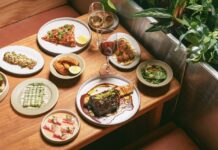Despite the cost-of-living crisis, analysts are predicting the growth in the out-of-home catering market is set to continue, following on from a 3% rise in growth in 2022 compared to 2019. To tap into this opportunity, there are two key requirements.
The first is using the latest technology to provide customers with the best possible digitally enhanced experience. The other is to tap into the public’s growing commitment to living more sustainably and wanting to be loyal to brands who share that worldview.

The key for restauranteurs is to be more digital and sustainable and combine both these attributes to provide an experience that stands out in the customer’s mind as truly enjoyable and, most importantly, original.
Apps removing friction
Some restaurants are pushing technology to its limits by providing the fastest possible, frictionless service. Rather than rely on staff to take orders, fast food outlets are now routinely switching to ordering from an app or an in-store digital screen. It frees up staff to be working on preparing food and cleaning their stations, but it also exposes clients to the full range on offer, with recommended extras and sides, and cuts down on the issue of a member of staff mishearing an order.
McDonald’s is a trailblazer for this type of technology, but it is not resting on its laurels. In Texas, at a test McDonald’s outlet, orders are placed via digital screens so they can be prepared by kitchen staff but the delivery of the food is made by a machine.
Additionally, apps are being used to go beyond ordering and arranging pick up, they are now keeping customers informed on the progress of their order. Just as usefully, customers are now able to pay for their order while they wait for their food, or when it is handed to them, via a restaurant’s app. The smartest tech now even allows people to split the bill with friends, all for the same order.
An extraordinary experience
AI is proving a game-changer in many industries and, even though there are concerns about its implications, it is increasingly becoming a part of our everyday lives.
It is well known for being able to crunch through mountains of data to personalise services for people, and that is how Raydiant has used the technology for its app. It can scan a customer to determine age, height, age and gender, as well as pick up a hint of what types of mood they’re in. In fact, it can do this for a group of people and then deliver a personalised menu for each customer.
Robots can also be just as controversial as AI but at the Asian restaurant L’Aigle Rouge, in Rennes, the emphasis is on helping human staff. Bella, as she is called, has a design customers find very pleasing with cat eyes and amusing expressions. She plays music as she moves around the restaurant and can even hold a conversation with customers as she takes orders to help deal with busy times.
Of course, robots can be used for mundane tasks, although customers are unlikely to come away with such a memorable experience as chatting to a cat-like robot. At the casual dining chain, Flunch, the robots on trial look very futuristic but are focussed on clearing and cleaning, freeing up staff to interact with customers.
If robots don’t sound futuristic enough, experts are convinced holograms could soon be making their way into restaurants. One of the most obvious implementations is likely to be a holographic menu which not only shows what is on offer but also displays a 3D image of exactly what the dish looks like when served. Taking it a step further, the next step is then likely to be adding garnishes and sides to truly personalise a plate.
Ultimately, the belief is that technology will allow people who are in different parts of the world to meet for a meal and interact with one another, as if they were seated opposite one another.
Towards zero waste
From where they source produce and the power to cook it, to how they treat waste, including left over food, restaurants are becoming increasingly aware of their role in the environment, particularly now customers are becoming increasingly eco-conscious.
Restaurant owners are becoming increasingly aware of the impact they have on the environment, and of their power to change attitudes on these societal issues. An obvious way restaurants can show their environmental and social credentials is in cutting down on waste food and, where possible, redistributing it to good causes.
Daylesford Organic, for example, distributes surplus produce from its farm and restaurant via the Too Good To Go app. It features huge household brands who make surprise bags of food available to customers at discounted prices. The app goes as far as estimating that a third of the food farmers produce can end up going to waste. The farm and restaurant business also supplies surplus food to The Felix Project which saves produce from being thrown away, sending it instead to charities who ensure it feeds someone in need.
Renewables and recyclables
Energy inflation has brought the high amount of power needed by restaurants to prepare and cook food, and so it follows that many companies are taking positive action. By using renewable sources, restaurants are not only hoping to cut their carbon footprint, but also their utility bills. The Chipotle Mexican Grill chain of fast-food restaurants is expecting investment in solar panels. It is hoping to reduce its use of gas and halve its greenhouse gas emissions by 2030.
Customers can be made aware of how seriously the chain wants to demonstrate its environmental credentials by seats made from cactus leather, rather than leather or plastic, and the works of art on display being made from recycled rice husks. Even the cutlery is biodegradable to prevent the build-up of waste for a future generation.
This is not the only restaurant chain to be thinking more environmentally about its furnishings. In South Korea, Starbucks has recently unveiled its 13th eco-friendly outlet. It backs up a zero-waste policy by converting recycled coffee grounds into furnishings. In fact, 56kg of used grounds have been converted into tables, lampshades, art walls, pots and trays.
Businesses do not need to be large household names to act. Gaucho opened its first outlet in Cardiff with a commitment to zero waste and to only use 100% renewable energy. Their products are more environmentally friendly than most too, with only carbon neutral beef making it to the menu.
Thinking about where the food comes and protecting the natural world around it is another theme that is emerging. Tigrus Holdings is launching two restaurants in the United Arab Emirates which are committed to a programme of reforestation and protecting animals in the regions where the group operates.
Socially responsible outlets
Aligning a restaurant with environmental causes is not the only way for a company to embody the values its patrons share with the brand. Mona, a Parisian café is dedicated to supporting women pursuing their own projects as well as supporting one another. This leads to regular meetings where views are exchanged and ideas shared through self-expression circles, book signings, conferences and sports classes.
Embracing and supporting a community is a sure-fire way to show the public that a brand truly shares their inclusive values. KFC in Pune, West India is a good example. It has been redesigned to be as accessible as possible. To do so, it did not stop at simply installing an adapted infrastructure that caters for people of all abilities, whether they are in a chair or standing. It has also invested in menus and store signage in braille and ensured sign language is understood by some members of staff.
This inclusive drive can be seen at restaurants who are proud to employ people from diverse backgrounds, such as Atout Coeur in Annecy which hires neurodiverse staff. The notion is that not only are people given pride in their work but also customers are expected to change their preconceived ideas of ordering food which is prepared and served by people with additional cognitive and mental needs.
A greener future
These restaurants are all early adopters of environmental values which will become a part of every-day dining, according to the Geco Food Service association. Its study, Horizon 2030: restaurants in transition, predicts restaurants will need to adapt in two ways. First, they will move to greener cuisine, by sourcing locally, committing to zero waste and power from renewables. Then they will also have to embrace diversity, both in terms of whom they employ and serve with menus for people with different dietary requirements and a range of physical impairments.
Interestingly, the study also points out that in Europe, 42.5% of households will be occupied by single people. This must be reflected in restaurant layouts and the warm welcome on offer to all clients, whether they are accompanied or eating on their own.









